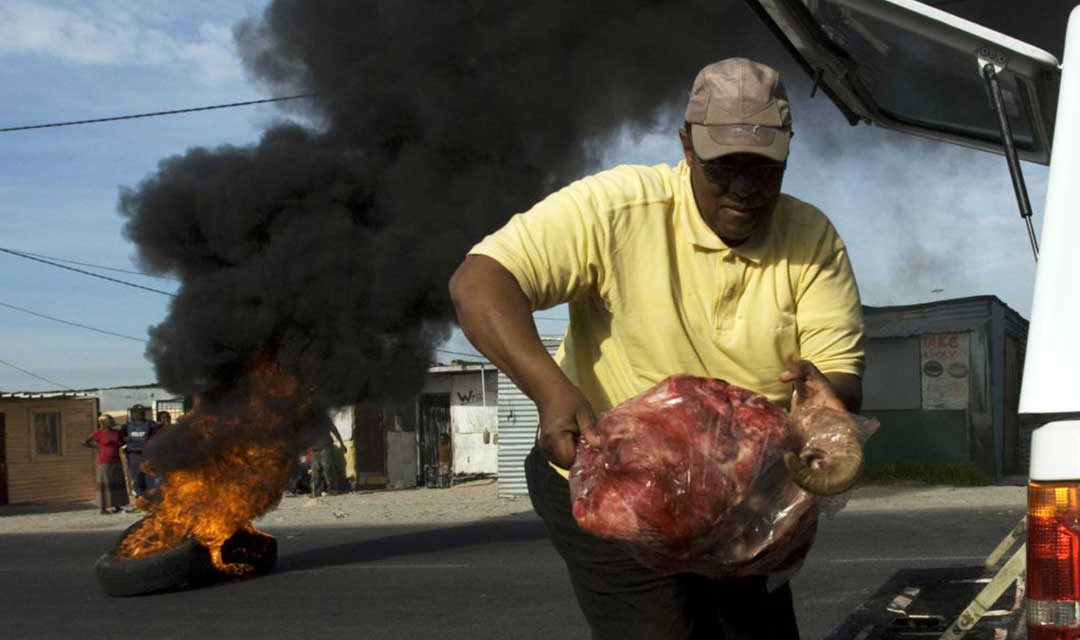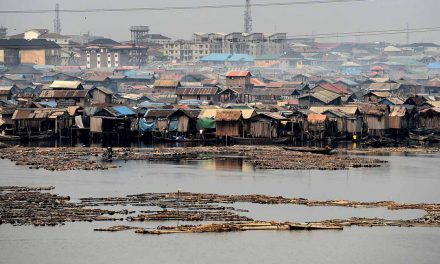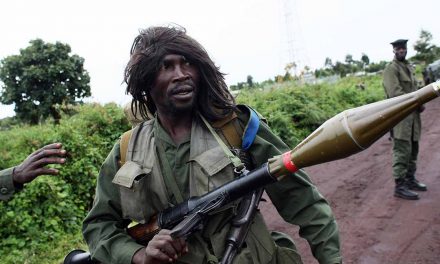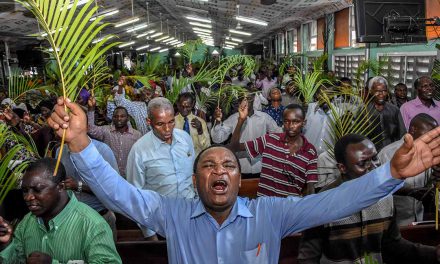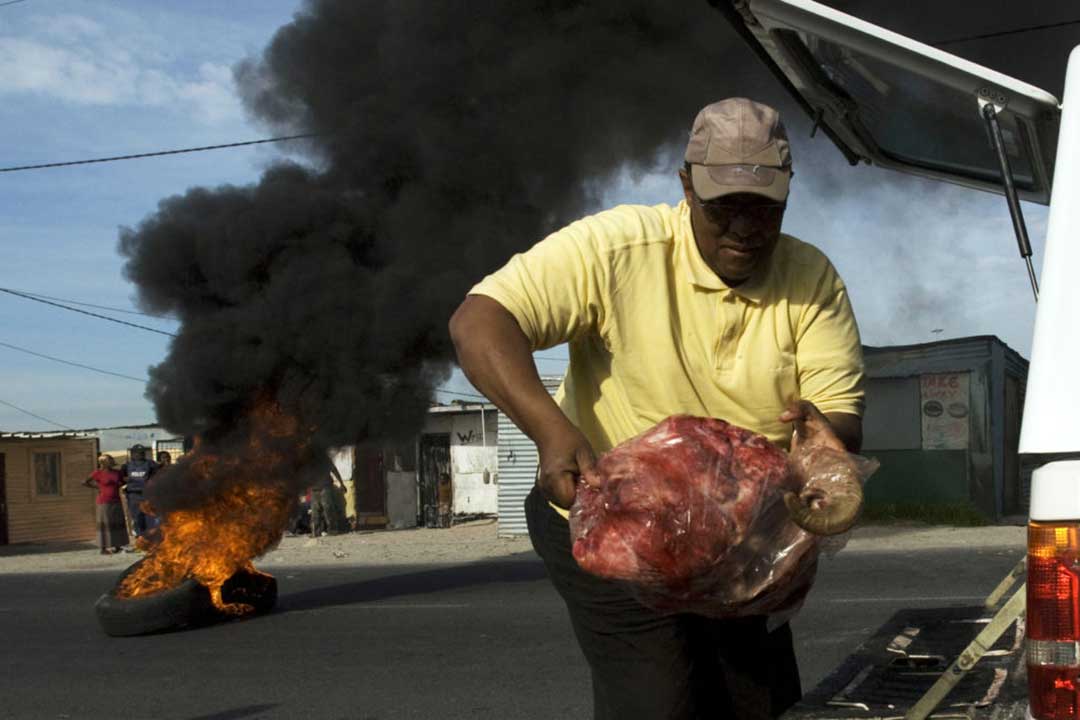
A man unloads meat as tyres, which were set alight during service delivery protests, burn behind him on June 2, 2010, in Monwabisi Park, Khayelitsha, about 30Km from the centre of Cape Town. South African police on June 1, 2010 arrested 26 protestors who burned tyres, threw stones and blocked roads over the removal of open-air toilets which have caused a stink for Cape Town officials. Police reacted to three separate uprisings in Khayelitsha, a poor shack-filled area in the east of the city, firing rubber bullets at two of the crowds. AFP PHOTO/ RODGER BOSCH (Photo by RODGER BOSCH / AFP)
South Africa: dying for change
In early 2012, Ayanda Kota, leader of the Unemployed People’s Movement (UPM) in the Eastern Cape, made his way to the Grahamstown police station. As an activist, he’d had an eventful year – to the extent that he had won some local fame, featuring in reports in Grocotts Mail, a community newspaper.
His visit to the station that day, however, had nothing to do with his public life; he was there to attend to a personal matter. Kota had misplaced some books he’d borrowed from Rhodes University sociology lecturer Dr Claudia Martinez-Mullen, who had laid a charge of theft against him in August 2011.
But the fact that he was now a media figure would have nasty consequences. He was about to experience violence that would shock the Grahamstown community. Arriving at the station, accompanied by Rhodes sociology lecturer Dr Richard Pithouse, Kota was recognised by six police officers who proceeded to assault him.
“A whole group of them just assaulted him,” Pithouse, who said he had witnessed the incident, told GroundUp in an October 2016 article. Forced to the ground, he was held down and kicked and punched. To humiliate him further, the police officers pulled down his pants and dragged him down a corridor while the abuse continued. “Look who is the newsmaker of the year now,” one of the policemen reportedly said.
The theft charge for not returning borrowed books was later withdrawn, but Kota’s treatment at the hands of the police outraged fellow activists across South Africa, who offered solidarity and support. With the help of the Socio-Economic Rights Institute of South Africa, Kota sued the South African Police Service (SAPS), which resulted in a R120,000 settlement. “What I experienced was hard and painful but the struggle must go on,” he said.
This was not the first time that Kota’s activism had resulted in violence and intimidation. Prior to founding the UPM, Kota was national secretary for political education for the Azanian Students Convention (AZASCO), a youth wing of the Azanian People’s Organisation (AZAPO). He left the organisation in 2001 after he received death threats and was assaulted by fellow members angered by his opposition to AZAPO leader Aaron Mosibudi Mangena’s appointment as deputy minister of education, which Kota believed was an ANC attempt to neutralise AZAPO.
Kota is unapologetic about his activism. As leader of the UPM, which he founded in 2009, he has consistently opposed the Makana Municipality of which Grahamstown is part. The UPM campaigns for better housing, water, sanitation and municipal services for Grahamstown residents. They also demand that South Africans are allowed more involvement in political decision-making processes that affect the country. Kota’s activism has given him a media profile on radio, in newspapers and online. As a form of protest, he has also been known to take faecal material to the premises of Makana Municipality as an expression of his contempt for the local authority’s failure to provide residents with clean water.
Both he and other UPM members have been subjected to telephonic death threats from anonymous callers, and the police have responded to UPM protest action with rubber bullets, baton charges, pepper spray and arrests. “What intimidation has taught us as activists for change,” Kota says, “is we must always be ready to take off the coat of fear.”
The UPM is not the only South African grassroots organisation whose members have been assaulted and intimidated, even killed, for challenging the status quo. Abahlali baseMjondolo (AbM) is a shack dweller’s movement, which campaigns against evictions and for public housing. Founded in 2005 and based largely in KwaZulu-Natal (KZN) – although it also has branches in various parts of South Africa – the organisation has about 50,000 members. Its general secretary, Thapelo Mohapi, claims that under the auspices of the ANC, activists are regularly assaulted and their homes raided. He gave the example of one incident in Cato Manor, Durban on 16 November last year, when the doors of people’s homes were reportedly kicked in and the properties raided. The home invaders assaulted people, five of whom were badly injured.
Abahlali baseMjondolo says its members have been tortured in police custody, while at least one activist has been murdered; two ANC councillors are currently serving life imprisonment for the 2014 assassination of Abahlali baseMjondolo member Thuli Ndlovu. And last year, Durban police confirmed there had been an attempt on the life of Abahlali BaseMjondolo member S’bu Zikode. His car was tampered with on two occasions and he was forced to go into hiding. Last year, too, armed men interrupted an Abahlali baseMjondolo meeting on the East Rand in Gauteng and threatened to fire shots in the air if the meeting was not stopped.
“Our members have faced torture and death threats from the police and members of the executive committee of the ruling party at branch level,” Mohapi said, speaking from Durban.
In 2014, Sello Mokhalipi, a former provincial chairperson of the Treatment Action Campaign (TAC), which campaigns for the treatment of HIV/AIDS was the target of intimidation. Mokhalipi, who split from the TAC and started a rival organisation, was part of a fierce battle the TAC waged against the Free State province health department over deteriorating health services. In an article on the Daily Maverick website in January 2016, Mokhalipi described receiving a threatening anonymous phone call demanding he stop his campaigning. “My activities were going to have a negative impact on the ANC and that it [sic] cannot be tolerated, especially while elections are around the corner,” he said. Mokhalipi was told he would be harmed if he disobeyed the caller.
A June 2018 article in South African weekly newspaper the Mail and Guardian reported there were 284 political killings across South Africa between 2000 and 2017, the majority of them in KZN. An earlier report, in 2013, noted there had been 447 political killings in KZN since 1994.
So why have South Africa’s independent civic activists and organisations found themselves on the wrong side of the police and members of the ruling party? In 2014, the Socio-Economic Rights Institute of South Africa released a report, which claimed that police and local government were criminalising protest action. According to the report, local authorities were manipulating legislation to enable them use force against people who were exercising their right to protest publicly.
One example given in the report was a 2014 incident in Philippi East, Cape Town, in which police used live ammunition to fire on protestors. Another Cape Town incident in 2014, which aroused public attention was a police raid on Siqualo, an informal settlement in Mitchell’s Plain. Police reportedly assaulted and arrested several people, including community leaders suspected of leading local protests against voter registration. A Siqualo resident, Lungiswa Bashe, whose shack was damaged in the raid, claimed that the police involved told residents they were acting on President Zuma’s instruction.
Clearly, members of community organisations who protest against poor state health care, lack of public housing and other government service delivery failures are being intimidated and harassed. The question is: why? According to Rhodes University sociology professor Lucien van der Walt, one reason is that politicians have a lot to lose in an environment where officials stand to corruptly benefit from private-sector tenders. “Politicians have a material stake in political intimidation and have a great deal to lose in leaving office,” he told Africa in Fact.
Proceedings before the South African Parliamentary Standing Committee on Public Accounts (SCOPA), which oversees the management of state funds, have exposed numerous examples of dodgy tender processes. Private-sector tender submissions to government are riddled with irregularities. Bidding processes that are supposed to be competitive have been nothing of the sort, with kickbacks to politicians and other state officials. Van der Walt suggests that state officials benefit financially from tendering processes to such an extent that they are afraid of losing these benefits, giving them a material stake in the intimidation of activists who threaten the status quo.
Dr Johan Burger, of the Institute for Security Studies (ISS), concurs that government members feel threatened by their opponents because they don’t wish to lose power. Government members, he says, feel so threatened by their opponents that intimidation is now a feature of South African politics. If government members feel threatened by their opposition, it is reasonable to assume that the likes of Kota instil significant fear in them. “And as there is an election pending,” Burger says, “acts of intimidation in some instances are likely, as they are part and parcel of our politics.”
Hugo van der Merwe, director of research at the Cape Town branch of the Centre for Study of Violence and Reconciliation (CSVR), says the right to protest is regularly violated and met with violence. “The issue of the right to protest is not sufficiently recognised and is often met with excessive violence,” he says. “This is an issue of great concern.” Both Burger and van der Walt suggest that the fear of losing power is a driving factor in the way government officials and their proxies respond to community-based protest action and service delivery activism. Kota’s assault at the Grahamstown police station and the intimidation and violence experienced by other community activists is illustrative of this fear.
These examples all amount to an abuse of critical human rights, including the right to protest, and clearly reveal an unmanaged fear of grassroots opposition that is defensive and suggests psychological inadequacies. Indeed, one is compelled to assume that some people in government, driven by fear of grassroots opposition, demonstrate poor psychological health in their intimidation of people who seek to bring change to South Africa.

